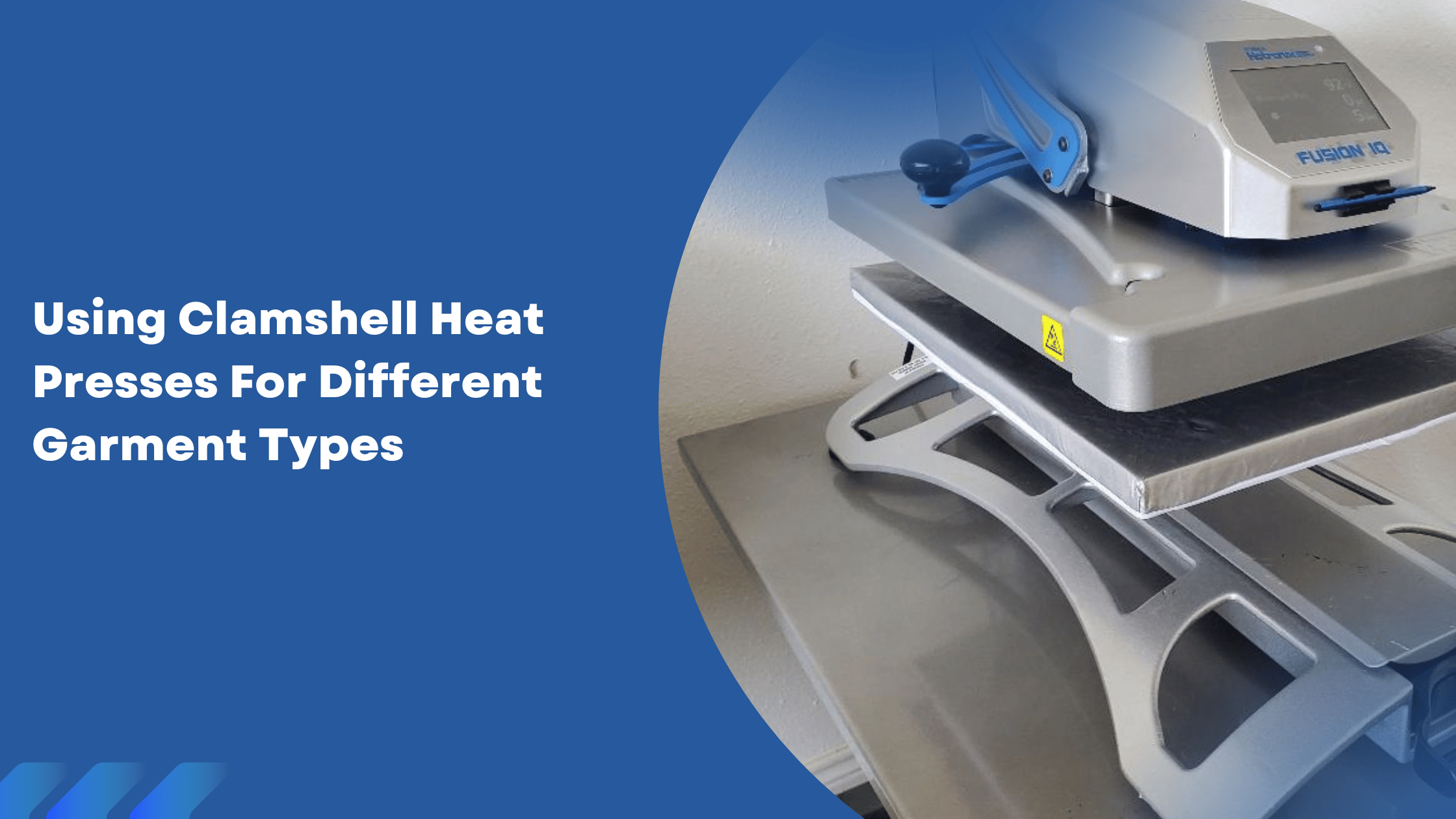The Versatility of Clamshell Heat Presses in Custom Apparel
Clamshell heat presses are among the most popular and efficient machines used by small businesses and print shops for custom apparel and heat transfer printing. Their compact design, ease of use, and consistent performance make them ideal for various production environments, especially those with limited space or fast turnaround needs.
But not all garments are the same.
Whether pressing cotton T-shirts, polyester jerseys, hoodies, or delicate blends, understanding how to optimize your clamshell heat press settings for each material type is critical. Using the wrong temperature, time, or pressure can lead to scorching, peeling, poor adhesion, or fabric damage.
This in-depth guide will explore how to properly use a clamshell heat press for different garment types, ensuring professional-quality results on every job.
Table of Contents
- What is a Clamshell Heat Press?
- Key Benefits of Clamshell Heat Presses
- Core Heat Press Variables: Temperature, Time & Pressure
-
Pressing Different Garment Types with a Clamshell Heat Press
- Cotton
- Polyester
- Cotton-Poly Blends
- Performance Wear & Moisture-Wicking Fabrics
- Spandex, Lycra & Stretchy Materials
- Hoodies & Thick Apparel
- Heat-Sensitive or Specialty Fabrics
- Choosing the Right Transfer for Each Garment
- Common Heat Press Mistakes by Fabric Type
- Tips for Optimal Pressing Across All Fabrics
- Final Thoughts
1. What is a Clamshell Heat Press?
A clamshell heat press features a hinge mechanism where the top platen opens vertically, similar to a clamshell. This space-saving design makes it ideal for small businesses or home-based shops.
These machines use controlled heat and pressure for a specific amount of time to apply designs onto garments using:
- Heat Transfer Vinyl (HTV)
- Sublimation transfers
- Direct-to-film (DTF) transfers
- Screen print transfers
2. Key Benefits of Clamshell Heat Presses
- Compact Design: Perfect for small spaces or home setups.
- Quick Operation: Faster cycles than swing-away presses.
- Affordable Pricing: Cost-effective without sacrificing quality.
- Great for Flat Items: Ideal for pressing T-shirts, tanks, and flat surfaces.
3. Core Heat Press Variables: Temperature, Time & Pressure
No matter what garment you're pressing, three critical variables determine your success:
Temperature
Heat is required to activate the adhesive during your transfer. Too low = weak adhesion; too high = scorching.
Time
The duration of the heat is applied. Under-pressing = incomplete transfer; over-pressing = discoloration or damage.
Pressure
The amount of force applied. Too little = poor bonding; too much = crushed fibers or bleeding designs.
Refer to the manufacturer's recommended settings for your specific heat transfer material.
4. Pressing Different Garment Types with a Clamshell Heat Press
A. Cotton
Cotton is the most forgiving and widely used fabric in heat pressing.
- Recommended Settings:Temperature: 320–350°F (160–177°C)
- Time: 15–20 seconds
- Pressure: Medium to Firm
Best Transfers:
- HTV
- Screen print transfers
- DTF
Pro Tips:
- Always pre-press cotton to remove moisture.
- Use firm pressure for full adhesion.
- Test darker cotton fabrics for potential discoloration.
B. Polyester
Polyester is a heat-sensitive synthetic fabric prone to scorching and dye migration (when dyes from the garment bleed into the transfer).
- Recommended Settings:Temperature: 280–300°F (138–149°C)
- Time: 10–15 seconds
- Pressure: Light to Medium
Best Transfers:
- Sublimation
- Low-temp HTV
- DTF with blocker underbase
Pro Tips:
- Lower temperatures are critical—avoid scorching.
- Use a heat transfer with dye-blocking capabilities.
- Always use a Teflon or parchment cover sheet.
C. Cotton-Polyester Blends
Blends are standard in modern apparel but can combine the challenges of both cotton and polyester.
- Recommended Settings:Temperature: 300–320°F (149–160°C)
- Time: 15 seconds
- Pressure: Medium
Best Transfers:
- HTV with dye-blocking
- Sublimation (light colors only)
- Screen print transfers (with low-temp adhesive)
Pro Tips:
- Watch for dye migration.
- Test press on sample garment before large runs.
- Use low-temp materials for darker blends.
D. Performance Wear & Moisture-Wicking Fabrics
These technical fabrics are often used in athletic gear and require special handling.
- Recommended Settings:Temperature: 270–290°F (132–143°C)
- Time: 10–12 seconds
- Pressure: Light
Best Transfers:
- Stretchable HTV (like Siser Stretch)
- Low-temp screen print transfers
- DTF with the stretch capability
Pro Tips:
- Use a heat press pillow to raise the print area and avoid seams.
- Avoid excess heat—moisture-wicking finishes can burn or discolor.
- Use flexible transfer materials to retain garment stretch.
E. Spandex, Lycra & Stretchy Materials
These materials are prone to melting or scorching but demand high-stretch transfers.
- Recommended Settings:Temperature: 250–275°F (121–135°C)
- Time: 8–12 seconds
- Pressure: Light
Best Transfers:
- Stretch HTV (like Siser EasyWeed Stretch)
- Silicone-based screen print transfers
Pro Tips:
- Always use a pressing pillow to avoid seams or zippers.
- Light pressure is key.
- Avoid layering—use single-press designs.
F. Hoodies & Thick Garments
Bulkier garments such as hoodies, sweatshirts, and jackets require more pressure and longer pressing times to achieve full adhesion.
- Recommended Settings:Temperature: 320–340°F (160–171°C)
- Time: 20–25 seconds
- Pressure: Firm
Best Transfers:
- HTV
- Screen print transfers
- DTF transfers
Pro Tips:
- Use a pressing pillow or platen extender to create a flat, even surface.
- Pre-press for 5–10 seconds to remove moisture.
- Be careful around thick seams and zippers.
G. Heat-Sensitive or Specialty Fabrics (Silk, Rayon, Modal)
Delicate fabrics are easily damaged under high heat, so extra caution is required.
- Recommended Settings:Temperature: 250–270°F (121–132°C)
- Time: 8–10 seconds
- Pressure: Light
Best Transfers:
- Low-temp HTV
- Water-based screen print transfers
- Cold peel only
Pro Tips:
- Always use a Teflon cover sheet to prevent direct contact.
- Perform multiple light presses instead of one long one.
- Test press on a small hidden area.
5. Choosing the Right Transfer for Each Garment
Not all transfers are ideal for every fabric. Here's a quick guide:
| Transfer Type | Best For |
|---|
| HTV | Cotton, blends, hoodies |
| Sublimation | 100% polyester (light colors only) |
| DTF Transfers | Cotton, blends, polyester, spandex |
| Screen Print Transfers | Cotton, blends, thicker garments |
| Stretch HTV | Spandex, Lycra, athletic wear |
6. Common Heat Press Mistakes by Fabric Type
| Mistake | Impact | Fix |
|---|
| Using cotton settings on polyester | Scorching, yellowing | Lower temperature to 280–300°F |
| Not using pressing pillow on hoodies | Uneven transfer, poor adhesion | Use pillow or raise platen area |
| Over-pressing spandex | Melting, fabric shrinkage | Reduce time and pressure |
| Skipping pre-press on cotton | Bubbles, peeling designs | Always pre-press for 5–10 seconds |
| Using sublimation on dark cotton | Dull or invisible transfers | Only use sublimation on white/light polyester |
7. Tips for Optimal Pressing Across All Fabrics
Always test on a sample—especially for new fabrics or transfers.
Pre-press garments to eliminate wrinkles and moisture.
Use heat-resistant tape for sublimation transfers to prevent shifting.
Check pressure by doing a "paper pull" test—paper should not slide easily.
Keep a heat settings log for different materials and transfers.
Clean your platen regularly to prevent adhesive buildup.
Use a Teflon or parchment cover sheet to protect the garment and platen.
Final Thoughts: Mastering Garment Variety with Clamshell Heat Presses
A clamshell heat press is a versatile and powerful tool for small businesses in custom apparel. But to get the most out of your machine, it's critical to understand how to optimize settings based on garment type.
Each fabric has unique heat sensitivity and pressure requirements, from cotton T-shirts to performance sportswear and thick hoodies. By following the guidelines in this article and testing your materials, you can consistently produce high-quality, long-lasting prints your customers will love.
Whether starting or expanding your product line, mastering garment-specific heat pressing with your clamshell press is the key to professional results and long-term business success.
Stay ahead. Press smarter. Grow faster.

